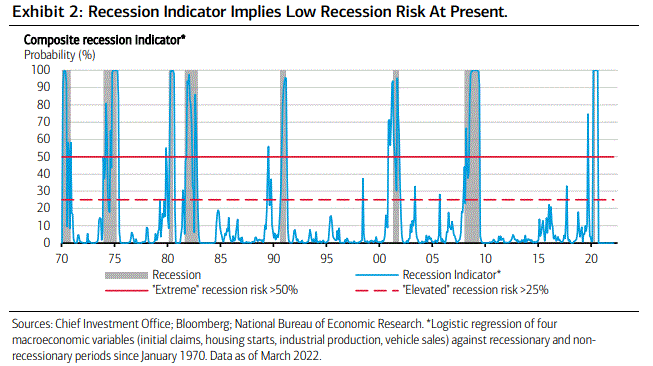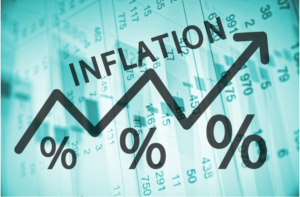Merrill har set på recessionerne siden 1970 og vurderer, at der ikke er nogen risiko for en recession år, som mange økonomer ellers frygter. Merrill bygger vurderingen på en recessions-indikator, som tager højde for flere økonomiske tendenser. Enkelte tendenser kan indikere en recession, men sammenlagt indikerer de ikke en fare. Merrill hæfter sig også ved, at centralbanken ført nu er begyndt at stramme pengepolitikken, og at den stadig fører en kurs, der sikrer en økonomisk vækst.
Assessing Recession Risk: The Recession Indicator
In light of the recent recession scare, we therefore revisit the Chief Investment Office (CIO) U.S.
recession indicator, which was first developed during the pre-coronavirus economic expansion.
This is a monthly series we have used as an input into our internal assessment of recession risk.
The indicator aims to gauge in a single measure how closely macroeconomic conditions
today—as captured by rates of change in key economic variables—resemble those that
prevailed in the past as the economy was entering a downturn. Many macro and market series
may of course be used to track the direction of economic activity. But the indicator includes four
fundamental variables, each based on real activity intended to capture distinct segments of the
economy. Each variable also has a sufficiently long monthly history to capture the eight
recessions that have occurred since 1970—a majority of the downturns in the post-war era. The
inputs used and type of activity intended for measure by the indicator are:
• Initial unemployment claims (labor market)
• Housing starts (residential construction)
• Industrial production (manufacturing)
• Vehicle sales (consumption)
The data points in each of these series are turned into an indicator of recession likelihood using
the logistic regression method. A typical linear regression describes the statistical relationship
between two continuous sets of data, while a logistic regression is used to establish the
relationship between a continuous set of input variables and a separate set of output results
that fall into discrete categories. It does so by assigning to each input a probability of falling into
either one of these categories, based on historical data.
In this case, the discrete categories are
“recession” and “no recession,” with the corresponding inputs as the monthly readings for each
of the four economic activity series. At the negative extreme, most of the historical data points
for each input have coincided with recessions, while at the positive end, most have
corresponded with periods of no recession. The indicator then gives recession probabilities for
each of the four series, which are combined into a single composite measure (Exhibit 2).
Historically, recessions have started within a few months of, or contemporaneous with, the
composite indicator crossing the 50% “extreme recession risk” threshold.

There have also been periods where the indicated probability has been relatively high at over
25%, but has not reached the 50% recession threshold. These periods of “elevated recession
risk” have occasionally occurred during economic expansions and were typically associated with
slower growth or an increase in market volatility, but not an outright recession or bear market in
Equities.
Throughout the current cycle, the indicator has remained at low levels. And the latest reading,
which incorporates data released in April for March, implies very low recession risk at present,
with no single input series in elevated or extreme territory.
We remain of the view that the Fed
is still in the very early stages of its tightening cycle and remains highly stimulative in the
current environment. But as monetary policy begins to move toward a more restrictive setting
over the period ahead, we will nonetheless continue to monitor the indicator as an additional
input among the range of economic and market data we track for any signs that a sustained
downturn could ultimately be approaching.










